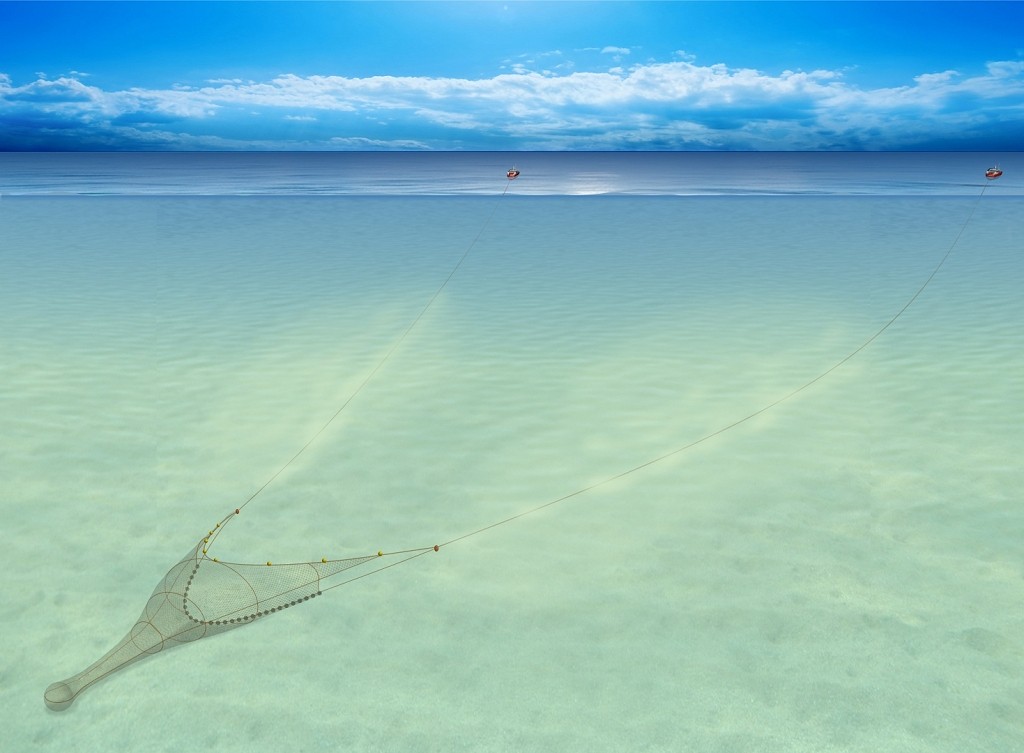Pair Seine
Alternative names
-
- Pair Trawl
Summary
In this fishing method a net similar to a demersal trawl is towed by two boats simultaneously, one towing each side of the trawl and held open by the distance apart of the vessels. The gear and way of operating a pair seine differs very little from a pair trawl except that the pair seine has a much greater length of rope and wire on the seabed, sweeping a much greater area of seabed.

Environmental impact
There will be some disturbance to the seabed through the contact of the sweeps and the ground gear of the net, but because pair seine gear does not need trawl doors, there will be reduced seabed impact.
However, despite the lack of trawl doors, pair seine gear will sweep a wider area of seabed than a single trawl. Usually, pair seine is used over sand, mud and shingle seabeds that are already subject to regular disturbance through the natural movement of tides and currents, therefore, any disturbance by the gear should have minimal long term effects. As with single boat demersal trawls, the vessels are strictly regulated through total allowable catch (TAC) and gear regulations to minimise environmental impact and by-catch.
As the gear is towed on the seabed, where, in many fisheries, there tends to be a mix of fish species, there is the opportunity for a by-catch of non-target species. The capture of immature fish is minimised by use of larger cod-end mesh sizes, some due to legislation but more recently as a result of the skippers choosing to use mesh sizes larger than the minimum dictated by regulation, to generally improve the selectivity of their gear and minimise discarding.
Other information
Traditionally, pair seine was actually developed as a way of keeping the seine net gear fishing for longer, thereby increasing catches. The gear is shot as a normal seine net by one vessel dropping a dhan, and shooting a long length of ropes, a net and a second side of ropes. But, instead of picking up the dhan again, a partner boat will pick up the dhan and that side of ropes, and the two vessels will tow the gear between them for a certain length of time, keeping the gear open longer, to extend the fishing time of the gear. When they are ready to haul the gear, the boats would close up together, and the dhan would be passed back to the original vessel, and it would haul the gear just as a standard seine net, slowly closing the ropes and net.
This method is still used in some overseas fisheries, but in the United Kingdom (UK) it has evolved more as a version of pair-trawl.
As this method evolved, the skippers started to add more seine net rope and wire to each side of the net to increase the area of seabed swept by the gear, thereby increasing the catching ability of the gear. Due to the long lengths used, it became more convenient for the vessels to handle the gear in a similar manner to a pair-trawl, with one vessel shooting the net, then passing one side of the net to the partner vessel, and both would then shoot their own side of the long lengths of rope and wire before towing the net between them for several hours, and hauling by reversing the process.
Modern pair seine in most European Union (EU) waters is, therefore, very similar to pair-trawling, but much longer lengths of seine net ropes and combination wire are used instead of trawl warp. On each side of the net, as much as 1,500 metres of wire and rope is towed on the seabed to herd fish from a wide area of seabed into the path of the net. The boats will be anywhere between 300 metres and 800 metres apart, depending on the depth of water and the amount of warp that is shot. Pair seine is usually used to sweep large areas of clean ground, whereas pair-trawl tends to be used in smaller areas of harder sea beds.
The vessels are virtually the same as that for pair trawlers or seine net vessels. Many vessels are equipped to fish using Scottish seine net, pair seine and pair-trawl, depending on the area they are in and what their target catch is at that time. Modern pair seine vessels are rigged with large capacity winches for hauling and storing the long lengths of wire and rope used to herd the fish into the net.
One of the problems of both methods is that the two vessels have to come close together to pass the tails of the net across. This can be hazardous in poor weather.
The main target species in the EU tend to be haddock, whiting and cod, rather than the bottom living species, although there will often be a by-catch of these species.
There will be some disturbance to the seabed through the contact of the sweeps and the ground gear of the net, but because pair-seine gear does not need trawl doors, there will be reduced seabed impact. However, despite the lack of trawl doors, pair-seine gear will sweep a wider area of seabed than a single trawl. Usually, pair-seine is used over sand, mud and shingle seabeds that are already subject to regular disturbance through the natural movement of tides and currents, therefore, any disturbance by the gear should have minimal long term effects.
Gear classification
Main target species (UK)
-
- Cod
- Haddock
- Hake
- Lemon Sole
- Ling
- Megrims
- Monkfish
- Plaice
- Pollack (Lythe)
- Saithe
- Whiting
Possible bycatch
-
- Any demersal species
- Immature round fish
- Juveniles of the target species